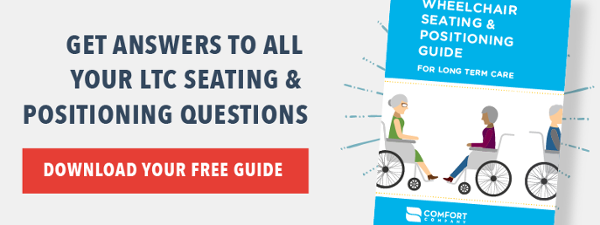How many times do we get a referral for “Mr. Smith” because he has an increase in lower extremity (LE) swelling, and the nursing home would like you to change his wheelchair in order to fix the issue? The facility wants you to give him ELRs, believing they will alleviate the swelling through “elevation”.
WELL GUESS WHAT? Those elevating leg rests won’t do anything to help the issue! Unless used in combination with tilt and recline often seen in power chairs, ELRs alone on the manual K0001 -K0004 wheelchair – the type typically seen in a nursing home – unfortunately CANNOT reduce edema.
We all learned how to reduce swelling in school: elevate the edematous extremity above heart level. ELRs don’t come close to elevating the legs above heart level. At best, they maintain the LEs extended straight out.
On the contrary, ELRs will decrease optimal circulation by cutting off blood flow at the groin area and inhibiting flow to the lower extremities. The LE may seem less swollen due to the fact fluid no longer pools at the ankles; however, you are not decreasing the edema at all.
Discuss these alternative edema control solutions at the next IDT meeting:
-
Make a schedule of time spent sitting in chair vs lying down with legs elevated above heart level for your resident
-
Provide compression stockings to compress the edema and stimulate circulation
-
Reduce sodium intake as sodium increases fluid retention
-
Increase resident’s water intake as water flushes excess sodium from the body
-
Decrease resident’s caffeine intake as caffeinated drinks contain a high level of sodium
-
Develop a walking schedule or an exercise schedule for your resident to increase circulation and fluid movement by pumping fluid from the edematous lower extremity back to the heart
-
Encourage the nursing staff to review any medications that may increase fluid retention such as hormone replacement drugs, calcium channel blockers, anti-depressants, and steroids known to increase edema. Consider substitutions without this side effect.
“ELRs reduce edema” is ONE OF THE GREATEST MYTHS out there, and, unfortunately, in the LTC setting they are used way too often. I know because I used to be guilty as charged! Not only are ELRs pricey (they add anywhere from $40-$100 to the price of the wheelchair), they are not addressing the issue at hand and lead to a list of other positioning issues that will be discussed in next week’s blog. Save that money for other positioning accessories or a cushion that will be more beneficial to the resident.
Hopefully this post gives you viable edema control alternatives to the use of ELRs. Discuss these solutions in the next care plan meeting or among the IDT to help the whole facility control edema of the LEs.
Join me next week to continue the discussion on misconceptions of ELRs.

Ana Endsjo, MOTR/L, CLT
Clinical Education Manager LTC Division
Ana Endsjo has worked as an occupational therapist since 2001 in a variety of treatment settings. She has mainly worked with the geriatric population, dedicated to the betterment of the treatment of the elderly in LTC centers. Her focus has been on seating and positioning and contracture management of the nursing home resident. With this experience, her hope is to guide other therapists, rehab directors, nurses, and administrators through educational guides, blogs, webinars, and live courses in her role as Clinical Education Manager for the long term care division.

